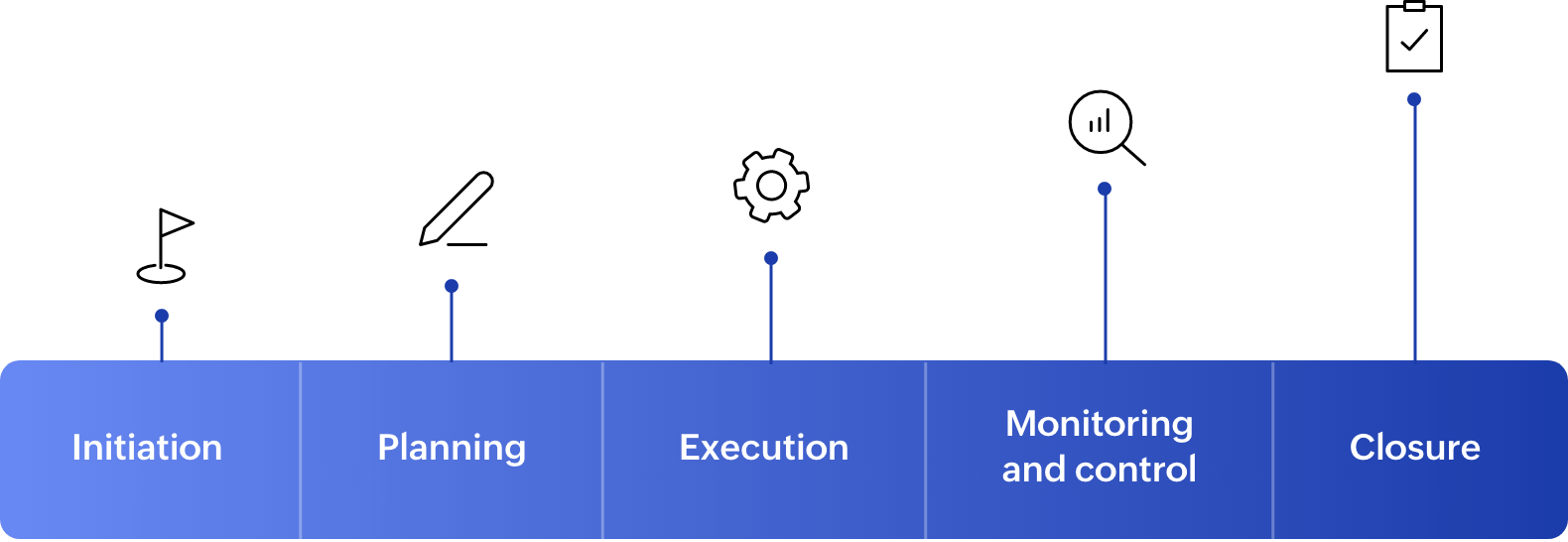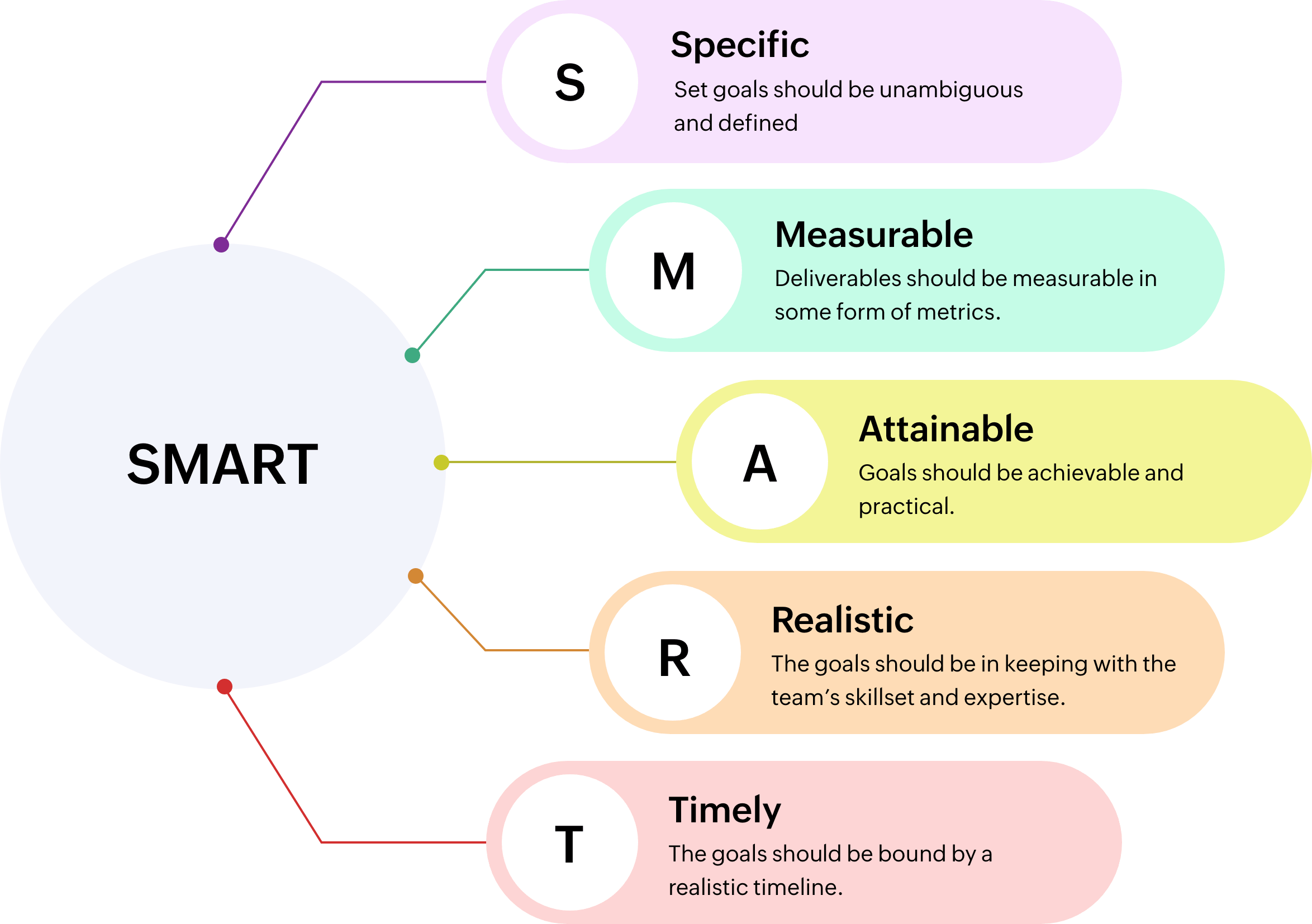Key takeaways
- There are five main phases in project management: initiation, planning, execution, monitoring and control, and closure.
- Zoho Projects can be your trusty project management software, guiding you through every project management phase.
A project phase is a set of activities whose completion denotes the accomplishment of a milestone.
For a project to make it to its end goal without a hitch, it has to adhere to the planned objectives, dodge any obstacles that crop up, strive for continuous improvement, and deliver unwavering success. These deliverables of uncompromising quality later coalesce to form the desired working product.
What's a better way to do it than splitting your project into phases, where each process is carefully vetted, assessed, and reviewed down to the finest detail? These 5 stages of project management involve in-depth discussions that encourage questions, followed by review meetings that decide the onward progression of the project.
What are the phases of project management?
Project management phases are the guiding blocks in a project's life cycle. There are five phases of project management, according to the Project Management Body of Knowledge. They are:
- Stage 1: Initiation, denoting the beginning of the project
- Stage 2: Planning, where the foundation for the project is solidified
- Stage 3: Execution, the stage where activities are carried out
- Stage 4: Monitoring and control, when the progress is tracked and measured
- Stage 5: Closure, when the project is formally turned in

The 5 phases of project management explained
Project initiation
Marking the conception of the project, the initiation phase is where the groundwork for the project commences. This is where an idea is turned to a goal. To ensure a smooth process, answer these questions:
- What is the problem that this project will solve?
- What are the project goals, duration, and budget?
- Who are the stakeholders?
- Is this project realizable?
It is in this phase that the objectives and project scope are defined, goals are given meaning, and two of the most crucial documents of the project are created. One is the project charter or the project initiation document (PID), which outlines the project overview, project budget and timeline, requirements and overarching scope of the project. The other is the stakeholder register that encloses the roles, the stakeholders' influence on the project, their interest, involvement, and communication preferences.
Let's take the example of a marketing campaign. The campaign objectives and target audience are defined, the scope, budget, and timeline are established, stakeholders and their roles are identified, and the purpose of the campaign and its deliverables are outlined in the project charter.
Project planning
Once the project is defined and goals are straightened out, we advance to the project planning phase. The longest of all project management stages, here is where the detailed roadmap takes form; the minutiae of your project scope, schedule, and communication plan are drilled down, and the moving parts of the project are synchronized. In short, your vague objectives are now given shape, and work is broken down into meaningful tasks that are allocated to relevant teams. There are various methods to go about the planning process, but two of the most commonly used ones are SMART and CLEAR.

SMART:Specific, Measurable, Attainable, Realistic, Timely
The SMART framework helps set, track, and accomplish clear and achievable goals in the most realistic way.
- Specific: Set goals should be unambiguous and defined.
- Measurable: Deliverables should be measurable in some form of metrics.
- Attainable: Goals should be achievable and practical.
- Realistic: The goals should be in keeping with the team's skillset and expertise.
- Timely: The goals should be bound by a realistic timeline.
For example, a fuzzy objective for a marketing campaign would be, "Increase brand awareness," while a SMART goal would be, "To increase brand awareness among South-East Asians living in North Dakota by 18-20% within eight months."
CLEAR:Collaborative, Limited, Emotional, Appreciable, Refinable

The CLEAR framework ensures that the established goals are transparent and in the team's best interest, while also establishing a well-defined budget and timeline.
- Collaborative: Goals should foster a sense of collaboration among working teams.
- Limited: The identified project budget and duration should have defined end points.
- Emotional: Goals should appeal to the team's passion and collective skills.
- Appreciable: Goals should be digestible and realistically attainable.
- Refinable: Goals should have wiggle room for modifications.
Scope creep is not an uncommon occurrence when a change management plan is out of the picture. It's key to develop an effective risk mitigation plan and a change management strategy to soften the blow caused by unforeseen project developments.
Establish a comprehensive marketing strategy, identify target audiences, dependencies, and milestones, define the medium of communication, and allocate tasks. An example of this would be a marketing campaign that invokes passion and involves collaboration among teams from different verticals, with tasks that can be broken down and distributed among employees.
Project execution
Now that the roadmap is set, all that's left is execution. Here's where the magic happens. Team members start on their assigned tasks, streamline workflows, and oversee progress. The project manager ensures that the stakeholders and teams are on the same page and aware of the project's developments.
Push the marketing campaign live according to the initial plan and design landing pages, videos, and graphics that are tailored to fit the theme of the campaign. Use tools that track insights in real time and measure results. Ensure that all the stakeholders are kept in the loop in case of any ad-hoc changes.
Project monitoring and control
The project monitoring and control phase occurs in tandem with the project execution phase, since progress can be monitored only once execution begins. The project manager conducts periodic review meetings and tracks real-time developments to ensure that the progress is in congruence with the project objectives. It's also the project manager's duty to address issues that may arise due to unforeseen delays or deviations in the project scope. Changes in budget, task allocation or the schedule can be quantified by measuring project performance against key performance indicators (KPIs) of critical success factors (CSFs).
This phase involves monitoring the campaign's performance by measuring insights like conversion rate, customer engagement, and clickthrough rate against the standard criteria, and creating change management strategies to dodge risks, avoid running the risk of budget overruns, and accommodate deviations.
Project closure
Marking the last juncture of the project phases, project closure indicates the concluding phase of the project. Teams turn in deliverables, close contracts, and sign off on paperwork, and the project manager holds a post-project review meeting to reflect on what went well, what could improve, and what lessons were learned. Such meetings account for increased transparency, shared learning, and better-managed projects in the future.
The closure of a marketing campaign includes comparing the campaign outcomes with the planned objectives, holding a formal closure meeting with the teams and stakeholders to discuss the successes and failures of the campaign, followed by sharing lessons learned for future references.
How can Zoho Projects help?
Segmenting a project into different project phases makes it easier to visualize and adapt to changes. With an ever-changing project landscape, it falls upon the project manager to effectively veer each one of the 5 stages of project management to its planned objective, but not without it resembling an uphill battle.
That's when the deployment of a smart project management solution like Zoho Projects becomes indispensable. From turning a hazy idea to a definite goal and everything in between, Zoho Projects has got your back every step of the way. Get a lot done in less time with automated workflows, contextual reports of real-time progress, customizable dashboards, time tracking, and so much more. Set yourself up for success, phase by phase.
FAQs on project management stages
What is a project lifecycle?
A project lifecycle is the phases of project management combined: initiation, planning, execution, monitoring and control, and closure. These phases steer the project towards its end goal, paving the road to project success.What is a stage in project management?
A stage or a phase in project management refers to a point where a collective set of tasks are carried out to complete a milestone. Completion of these project stages or project phases indicates the project conclusion.